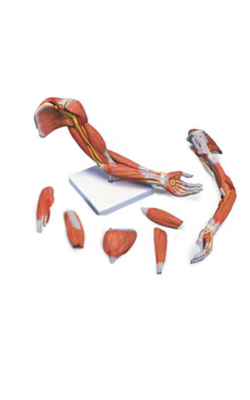Main Model

23 Ulnar nerve

Ulnar Nerve in Arm
The ulnar nerve in the arm passes distally from the axilla anterior to the insertion of the teres major and to the long head of the triceps, on the medial side of the brachial artery. Around the middle of the arm, it pierces the medial intermuscular septum with the superior ulnar collateral artery and descends between the septum and the medial head of the triceps. The ulnar nerve passes posterior to the medial epicondyle and medial to the olecranon to enter the forearm. Posterior to the medial epicondyle, where the ulnar nerve is referred to in lay terms as the “funny bone.” The ulnar nerve is superficial, easily palpable, and vulnerable to injury. Like the median nerve, the ulnar nerve has no branches in the arm, but it also supplies articular branches to the elbow joint.
Ulnar Nerve in Forearm
Like the median nerve, the ulnar nerve does not give rise to branches during its passage through the arm. In the forearm it supplies only one and a half muscles, the flexor carpi ulnaris (as it enters the forearm by passing between its two heads of proximal attachment) and the ulnar part of the flexor digitorum profundus, which sends tendons to the 4th and 5th digits. The ulnar nerve and artery emerge from beneath the flexor carpi ulnaris tendon and become superficial just proximal to the wrist. They pass superficial to the flexor retinaculum and enter the hand by passing through a groove between the pisiform and the hook of the hamate.
A band of fibrous tissue from the flexor retinaculum bridges the groove to form the small ulnar canal (Guyon canal). The branches of the ulnar nerve arising in the forearm include unnamed muscular and articular branches, and cutaneous branches that pass to the hand:
• Articular branches pass to the elbow joint while the nerve is between the olecranon and the medial epicondyle.
• Muscular branches supply the flexor carpi ulnaris and the medial half of the flexor digitorum profundus.
• The palmar and dorsal cutaneous branches arise from the ulnar nerve in the forearm, but their sensory fibers are distributed to the skin of the hand.
Ulnar Nerve in Hand
The ulnar nerve leaves the forearm by emerging from deep to the tendon of the flexor carpi ulnaris. It continues distally to the wrist via the ulnar (Guyon) canal. Here the ulnar nerve is bound by fascia to the anterior surface of the flexor retinaculum as it passes between the pisiform (medially) and the ulnar artery (laterally).
Just proximal to the wrist, the ulnar nerve gives off a palmar cutaneous branch, which passes superficial to the flexor retinaculum and palmar aponeurosis and supplies skin on the medial side of the palm.
The dorsal cutaneous branch of the ulnar nerve supplies the medial half of the dorsum of the hand, the 5th finger, and the medial half of the 4th finger. The ulnar nerve ends at the distal border of the flexor retinaculum by dividing into superficial and deep branches.
The superficial branch of the ulnar nerve supplies cutaneous branches to the anterior surfaces of the medial one and a half digits. The deep branch of the ulnar nerve supplies the hypothenar muscles, the medial two lumbricals, the adductor pollicis, the deep head of the flexor pollicis brevis, and all the interossei. The deep branch also supplies several joints (wrist, intercarpal, carpometacarpal, and intermetacarpal). The ulnar nerve is often referred to as the nerve of fine movements because it innervates most of the intrinsic muscles that are concerned with intricate hand movements.